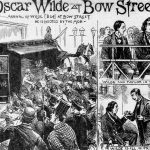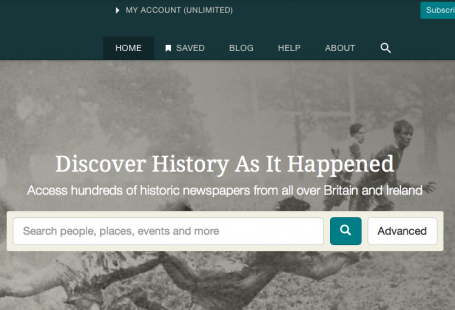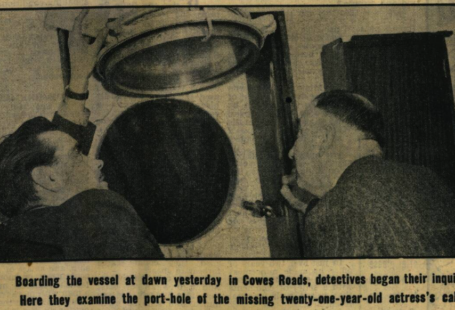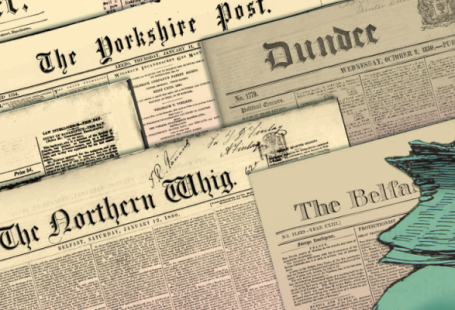As part of our celebration of Pride Month, we are delighted to welcome a very special guest post from Vicky Iglikowski-Broad, who works as the Principal Diverse Histories Records Specialist at The National Archives. In this blog, Vicky Iglikowski-Broad explores one of the latest specialist titles to be added to the British Newspaper Archive, namely Link. Read on to discover more.
Register now and explore The Archive
Amongst the myriad of publications that developed in the early 20th century was a curious little periodical originally called Cupid’s Messenger. The full run of the publication is held by the British Library and digitised versions have just been made available on the British Newspaper Archive.
This small print booklet was essentially a lonely-hearts publication for the era, enabling people to meet other people through classified adverts; for love, lust and friendship. The pages are full of little insights into people’s lives. In approximately 25 words men and women would describe themselves and what they were looking for.
Bachelor Girl (Scotland), 27, happy-go-lucky, sociable, fond of reading, though not a “blue-stocking,” will be glad to make interesting “pen-friends” who care for correspondence.
Areo (Guildford), 28, engineer, wishes to meet with refined affectionate lady, 20 to 25, one prepared to be honest, sincere and anxious to have a boy friend.
The publication ran from 1915, when the proprietor Alfred Barrett identified a crisis of loneliness in the midst of the First World War, but the publication wound up in 1921 under a cloud of disrepute.
The way that the lonely-hearts publication framed itself changed over time. The first issue ran with the subheading ‘the only monthly practically devoted to love interests;’ its pages containing introductory essays and snippets of poetry as well as a few pages of personal advertisements. By 1916 the publication was known as The Link with the much broader strap line, ‘a medium for finding your friends’ while later additions ran with the line ‘A Monthly Social Medium for Lonely People – Not matrimonial.’ The ‘not matrimonial’ phrase and the way it was interpreted was key. By the later additions, the majority of pages contained classified adverts.
But the content of the publication also slowly changed in another way too. In 1920 the publication had come to the attention of the Metropolitan Police, and the surviving police file can be found in the collections of The National Archives. Seemingly, against the original intentions a certain type of personal advertisement was increasing to be found, loaded with coded and suggestive language; these featured men looking for other men and women looking for other women.
The majority of these type of adverts were written between men, which was extremely risky in 1920s Britain when homosexual acts between men were criminalised. To express your intentions in a written form was an even greater danger; as it could be used as evidence against you, hence the use of coded language.
A letter from R A Bennett, editor of the moralising newspaper Truth, had been sent to the Metropolitan Police expressing concern about the publication. Bennett complained, ‘what leads me to write to you, is the section devoted to the male sex, where the advertisers seem to be running up against the criminal law’ (The National Archives, MEPO 3/283).
The Link, A Monthly Social Medium for Lonely People, No. 56. September 1920. The National Archives: MEPO 3/283
While the police investigations are interesting and important in themselves, even more so are the wonderful insights into the LGBTQ+ community that the publication gives. The classified adverts show how it was possible to meet members of the same sex when your love was essentially criminalised or demonised by society. The small advertisements contained phrases such as ‘unconventional’, ‘jolly’ and ‘bohemian’. The language used links to gay stereotypes of the era, including allusions to literature, art and culture, to signal the writer’s sexuality. Often this involved listing high profile figures that represented a kind of queer artistic cannon, notably Oscar Wilde, socialist Edward Carpenter, who openly published about sexuality, and the American poet Walt Whitman.
These small snippets into people’s lives also show us that LGBTQ+ love wasn’t London-centric or anchored to metropolitan areas. People wrote classified ads from many different locations, from Lowestoft to Liverpool, and Somerset to Canada. This may seem unsurprising, but often the material evidence can be hard to find. We also get an insight into people’s class background and jobs – a real cross section of society is captured.
The adverts themselves are wonderful to read and deserve to be trawled through for hours. Such as:
Professional Musician (London Southsea), 30, artistic, literary tastes, nice appearance, horribly lonely, wants young male chum, 20-30, refined, understanding nature welcomed. Position no account.
Advertiser (London, S.E.) wants one congenial male chum, 18-25 or thereabouts. No girl hunters. Photo appreciated and returned.
Idealist (London, S.W.), 31, well-educated man, artistic, genuine, broad-minded, tall, decent-looking, firm believer in Carpenter’s books, wishes meet men similar disposition. Photos welcomed.
There was also a smaller selection of personal adverts between women using coded language. These use slightly different terms:
Young Lady (B’ham), 19, refined, would be pleased to meet jolly girl as friend for evenings and week-ends. Residing B’ham preferred.
Unconventional (Wales), 30, well-educated, literary tastes, fond of travel, dancing, good times, and studying human nature, would like correspondence.
But ultimately the police were far less interested in these adverts between women because they weren’t contravening the law. Women having sexual relationships with other women was never illegal in England.
Records at The National Archives show that not only did people send in these classified adverts, but that they also lead to men meeting and having sexual relationships. Sadly, we know this as subsequent love letters were seized by police. One couple were Ernie and Geoff, you can find more about their relationship here.
A selection of love letters found by the police on Ernest [Ernie] Smyth in Belfast. The National Archives, MEPO 3/283.
The Link was ultimately investigated for conspiracy to corrupt public morals, which is why two copies are in the Metropolitan Police files at The National Archives, however the full run of Cupid’s Messenger and The Link are in the British Library collection. Four individuals were charged with conspiring to corrupt public morals, including Alfred Barrett, Ernest and Geoff. Each received two years’ imprisonment with hard labour at Wormwood Scrubs.
The Link shows a defiance to live and love despite the law and the creative ways lesbian, gay and bisexual people determined to do this in the early twentieth century. One hundred years on, people still instinctively crave ways to meet other people, whether it is through online dating apps or classified advertisements. The legacy of these publications lives on. I urge you to take a look at The Link and Cupid’s Messenger, and rediscover the hidden queer voices of the past that they contain.
Vicky Iglikowski-Broad works at The National Archives as the Principal Diverse Histories Records Specialist. In 2019 she ran an event, Classified, at the Royal Vauxhall Tavern with the drag artist Timberlina and DJ Auntie Maureen to bring the classified advertisements of The Link back to life and reflect on how much has changed in the last hundred years for LGBTQ+ people.











